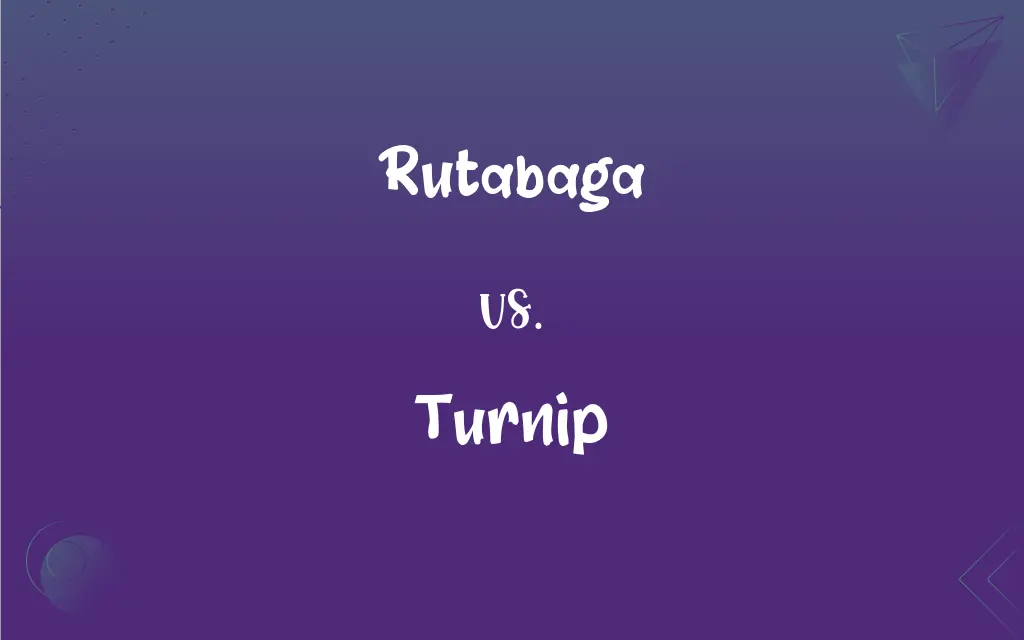Rutabaga vs. Turnip: What's the Difference?
Edited by Aimie Carlson || By Janet White || Published on March 17, 2024
Rutabaga is a larger, sweeter root vegetable with yellow flesh, while turnip is smaller, with white flesh and a peppery taste.

Key Differences
Rutabagas are root vegetables that are part of the Brassicaceae family, known for their large size and yellow to orange flesh, which tends to be sweeter and denser than that of turnips. Turnips, on the other hand, are generally smaller, with white flesh that can have a slightly peppery flavor, making them distinct in both taste and texture.
Cultivation of rutabagas is common in colder climates where they mature in longer seasons, as they require more time to grow than turnips. This results in a vegetable that can be stored for an extended period, making rutabagas a staple winter food in many regions. Turnips grow faster and can be harvested in both spring and fall, providing a more versatile growing season.
In the kitchen, rutabagas are often used in stews, soups, and roasted vegetable dishes, prized for their ability to absorb flavors while contributing a sweet depth. Turnips, with their lighter flavor and texture, are frequently eaten raw in salads, pickled, or lightly cooked, offering a crisp, refreshing bite that contrasts with the hearty nature of rutabagas.
Nutritionally, both rutabagas and turnips provide essential vitamins and minerals, including Vitamin C, fiber, and potassium. However, rutabagas generally have a higher content of carbohydrates and sugars, reflecting their sweeter taste, whereas turnips contain fewer calories and carbs, making them a lighter option.
Despite their differences, both rutabagas and turnips share a botanical lineage that confuses many, yet their distinct characteristics in flavor, culinary uses, and nutritional profiles set them apart as unique vegetables in their own right, each bringing its own benefits and tastes to the table.
ADVERTISEMENT
Comparison Chart
Size
Larger and denser
Smaller and lighter
Flesh Color
Yellow to orange
White
Taste
Sweeter
Slightly peppery
Growing Season
Longer, prefers colder climates
Shorter, adaptable to spring and fall
Culinary Uses
Stews, soups, roasted dishes
Raw in salads, pickled, lightly cooked
ADVERTISEMENT
Nutritional Content
Higher in carbohydrates and sugars
Lower in calories and carbohydrates
Storage
Stores well, good for winter
Shorter storage life
Texture
Denser and firmer
Crisper and more watery
Harvest Time
Late fall
Spring and fall
Cultural Significance
More common in northern Europe and America
Widely used globally, ancient cultivation
Rutabaga and Turnip Definitions
Rutabaga
Known for its yellow to orange flesh.
I mashed rutabaga as a nutritious alternative to potatoes.
Turnip
A small, white-fleshed root vegetable with a peppery taste.
I added raw turnip to the salad for a crunchy texture.
Rutabaga
A staple in northern climates due to its storage capability.
We stored rutabagas over winter for a continuous food supply.
Turnip
Grows quickly and can be harvested in spring or fall.
We harvested turnips early to enjoy them fresh in spring salads.
Rutabaga
Larger and denser than its cousin, the turnip.
The rutabaga in the stew added a rich, sweet taste.
Turnip
Eaten raw for its crisp and refreshing bite.
The sliced turnip made a perfect snack on a warm day.
Rutabaga
A hardy root vegetable with a sweet flavor.
I roasted rutabaga with carrots for a hearty winter dish.
Turnip
Lower in calories, making it a lighter dietary option.
I opted for turnips to keep the meal light yet flavorful.
Rutabaga
Often used in soups and stews for its sweet depth.
The rutabaga added a unique sweetness to the beef stew.
Turnip
Versatile in cooking, from pickling to light cooking.
I pickled turnips to add a tangy flavor to sandwiches.
Rutabaga
A plant (Brassica napus var. napobrassica) in the mustard family, having a thick bulbous yellowish root used as a vegetable.
Turnip
A widely cultivated Eurasian plant (Brassica rapa) of the mustard family, having a large rounded edible whitish root and edible leaves.
Rutabaga
The edible root of this plant. In both senses also called swede, Swedish turnip.
Turnip
The root of this plant, eaten as a vegetable.
Rutabaga
The swede, or Swedish turnip; the European plant Brassica napus var. napobrassica
Rutabaga
The edible root of this plant
Rutabaga
The large yellow root of a rutabaga plant used as food
Rutabaga
A cruciferous plant with a thick bulbous edible yellow root
FAQs
Are rutabagas and turnips interchangeable in recipes?
They can be, but their taste and texture differences will affect the dish's outcome.
Which has a sweeter taste, rutabaga or turnip?
Rutabagas are sweeter than turnips.
What is a turnip?
A smaller root vegetable with white flesh and a slightly peppery taste.
How can you tell rutabagas and turnips apart?
Rutabagas are larger with yellow-orange flesh, while turnips are smaller with white flesh.
What is a rutabaga?
A large, sweet root vegetable with yellow-orange flesh.
What are turnips best used for in cooking?
They're versatile, great raw in salads or lightly cooked.
Which vegetable is more calorie-dense, rutabaga or turnip?
Rutabagas are more calorie-dense due to their higher carbohydrate content.
Which grows faster, rutabagas or turnips?
Turnips grow faster than rutabagas.
What are the best conditions for growing rutabagas?
Cool climates and a long growing season.
Can turnips be eaten raw?
Yes, turnips can be enjoyed raw, offering a crisp and peppery flavor.
Are rutabagas good for storage?
Yes, they store well and are ideal for winter use.
Can you eat the greens of both vegetables?
Yes, the greens of both rutabagas and turnips are edible and nutritious.
What's the best way to cook turnips to retain their crispness?
Brief cooking methods like steaming or stir-frying keep them crisp.
What nutrients are abundant in rutabagas?
They're rich in Vitamin C, fiber, and potassium.
What makes turnips a good choice for a healthy diet?
Their low calorie and carb content, along with the ability to be eaten raw, make them a healthy option.
Why might someone choose rutabagas over turnips?
For their sweeter taste and denser texture, suitable for hearty dishes.
How should rutabagas be prepared for cooking?
They can be peeled, chopped, and then roasted, boiled, or mashed.
What is the nutritional benefit of turnips?
Turnips are low in calories and carbs, providing Vitamin C and fiber.
How long can you store turnips?
They can be stored for several weeks in a cool, dark place.
Can rutabagas be used in desserts?
Yes, their sweetness can complement certain dessert dishes.
About Author
Written by
Janet WhiteJanet White has been an esteemed writer and blogger for Difference Wiki. Holding a Master's degree in Science and Medical Journalism from the prestigious Boston University, she has consistently demonstrated her expertise and passion for her field. When she's not immersed in her work, Janet relishes her time exercising, delving into a good book, and cherishing moments with friends and family.
Edited by
Aimie CarlsonAimie Carlson, holding a master's degree in English literature, is a fervent English language enthusiast. She lends her writing talents to Difference Wiki, a prominent website that specializes in comparisons, offering readers insightful analyses that both captivate and inform.































































